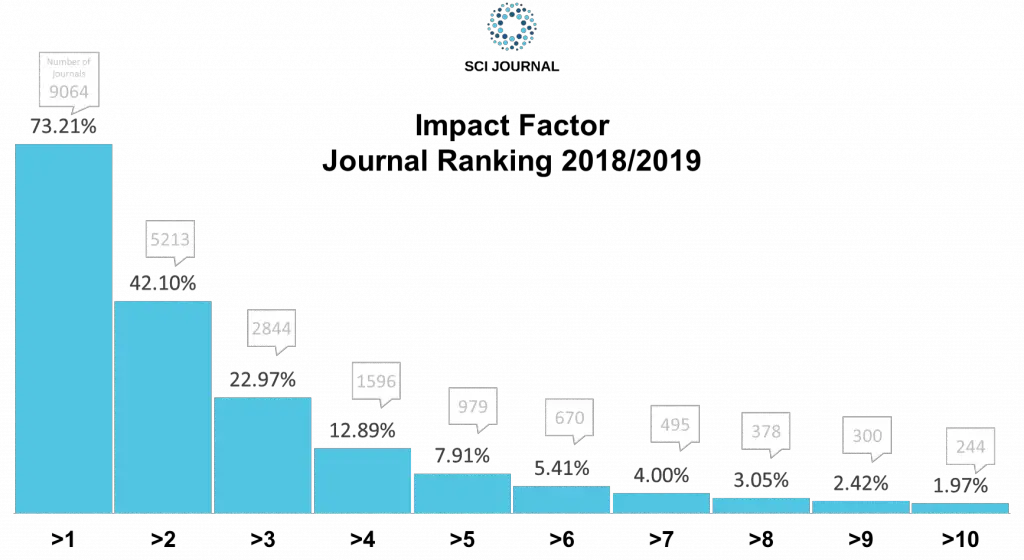Science – something that is hard to define by just one word.
It is intriguing, vital, innovative, difficult, mind-blowing, and more. All at once? Easily!
And a lot of scientific information goes into science journals. With thousands of active journals and hundreds of thousands if not millions of papers and articles published yearly, it’s quite easy to get lost.
And this is where Impact Factor comes in.
It is one significant tool available that you can use to compare journals in a subject category and it is more than important to find out more about it if you care about science, reading, and discovery.
Table of Contents
Before We Start: Know the Definition & History
Just before we start, let‘s explore the impact factor‘s history and definition so that we are clear and ready to move along the steps!
So, what exactly is the impact factor in a more simple explanation? Also known as the journal impact factor, it is a measured frequency that shows us how many times articles from a journal have been cited in a particular year. This allows determining the rank and importance of the journal by calculating the number of times its articles have been cited.
What about its history? While the idea itself was first mentioned all the way back in 1955, the impact factors started calculating from 1975 and were devised by the founder of the Institute of Scientific Information – Eugene Garfield.
You might also be interested in the topics below:
- 19 Ways to Increase Impact Factor
- Tips to get published in top science journals
- Academic Search Engines You Might Not Know
- Best Academic Writing Tools
- Ultimate Academic Resources
Step 1: What‘s a Good Impact Factor
While It was created for the sole purpose of helping to select additional source journals by implementing a simple calculation: The impact factor of a journal is the number of citations, received in that year, of articles published in that journal during the two preceding years, divided by the total number of “citable items” published in that journal during the two preceding years.
It is more than important to know what‘s a good impact factor! One might say – just look at the numbers and highest wins. But the impact factor goes beyond that, and numbers aren‘t absolute.
In most fields, the impact factor of 10 or greater is considered an excellent score while 3 is flagged as good and the average score is less than 1. This is a rule of thumb. However, the wild card to pay attention to is that impact factor and comparing journals are most effective in the same discipline.
The impact factor is a subjective matter and has the most meaning only when comparing journals within similar fields. A good example is a journal in physics where a score of 2 is often considered excellent, meanwhile, experimental material sciences have a great number of pieces rated over 10.
This is why at SCIJournal.Org you will be able to locate any specific journal in any of the 27 major research categories with ease.
Step 2: Impact Factor Examples & Annual Statistics
We have tracked impact factors for about 13,000 selected scientific journals in 27 major research categories. In the table below you will be able to see both the percentage and number of journals that had impact factors from 0 to 10+.
Let’s start with some facts:
- Very few journals (1.97%) have an impact factor of 10 or higher
- Most journals (73%) have an impact factor equal to or greater than 1

One way to use this chart to look at a journal impact factor, if it‘s higher than 1, then it means it‘s in the club of the 70%; higher than 2 then it‘s in the club of 40%. Very few (less than 2%) make it in the more than 10 category. This is of course an initial assessment of a journal by looking at its impact factor.
By looking at its number, you immediately should have a sense of where it stands in the massive pool of SCI journals.
Let’s also be mindful that different research areas have its own range of impact factor.
Following is a useful table to show you the key journal impact factors by major research categories. By using this chart, you can quickly determine where a journal sits in the 4 classes: top 80%, top 60%, top 40%, and top 20%. Note that we have singled out the effect of outliers which could distort the average as well as the percentiles.
For example, if you look at a Medicine journal which has an impact factor score of 1.5, then this tells you that its very close to the top 60% of Medicine journal.

Source: scijournal.org
Step 3: Does Impact Factor Actually Matter?
I would venture to say that most tools were created with good intention.
What matters is how a tool or an indicator is used.
The impact factor was mainly created for the librarians according to Nobel Laureate Martin Chalfie. The idea is to help the librarians spend their budget on the most-read journals. Not the most important journals. And, much less the merits of a paper or a journal.
But, then once you have a metric for a journal. People start abusing this metric. Faculties or institutions start to use impact factors to support their decision on who to hire, fire, promote, etc.
There‘s no secret that controversy does surround the impact factor and constantly questions its true impact and value. Examples range from downright manipulation of publication numbers and self-citation issues to disciplinary differences.
Because of the heavy reliance on impact factors as an indicator, the phenomena has created lots of wrong incentives for people to hack the metrics. We can’t blame our members for reacting in a certain way when the performance of their jobs is being tied to a single metric such as the impact factor. A lot of stakes are on the table.
So, the number should be a matter of what role should Impact Factor play and how much importance should we place on it. Unfortunately, most of the time, scientists and researchers are the ones that price a high premium over the impact factor.
Management issues are usually the source of controversies around the role of impact factors in the scientific world and publishing. Eventually, we will get ourselves into a debate of the role of science. But, few will argue that science should serve mankind and have practical value.
In certain circumstances, the impact factor might be questionable and sometimes even vulnerable to rogue managers, but it does tell you something about the impact of a science journal. Today, managers use it to check whether they are on track.
Librarians use it to guide their purchase decision. Researcher teams use it to maximize the impact and visibility of their research. Publishers use it for both marketing and competitive analysis purposes.
In the end, the impact factor can‘t be ignored, and all those metrics and calculations are there for a good reason.
Step 4: Is There A Danger in Low Impact Journals?
Is there a danger in a low impact journal? A question that might seem interestingly odd and curious. But it is not the articles themselves that might be hazardous, but the nature of publishing and reputation of low impact journals that might hide high-quality works under its wing.
A number of cases are known throughout the history where articles were ignored because it was published in unknown and obscure journals. And yet gained a lot of credit when the same work was published in high impact and well-read journals.
A survey was done in Brazil also observed what lies beneath some of the low impact journals. For some, even with dedicated knowledge and time, it might be hard to publish in high impact factor journals due to reasons such as inequalities in geography, finances, and language.
Just as any sector on the planet, science journals, and impact factor still have work to do to become more proficient, but there‘s no doubt that many are seeking to get their work printed in a journal that is measured highly by impact factor metrics.
Moreover, perhaps, we should be aware of the fact that most journals are in the average range of impact factor and even some reputable journals don’t score high in impact factor. We have included a chart for each of the 27 major research categories at the bottom of this article to give you a sense of how impact factors distributed in different areas.
Step 5: Assessing the Impact with Other Indicators
We have one last step, and assessing the impact with other indicators is where we are going with our ultimate stride.
It is very important to keep in mind that any journal impact factor or scientometric indicator alone will not paint the full picture of a scientific journal. That is the reason why scholars review current metrics, come up with new ones or improve them each year.
The impact factor has been mostly criticized for being overly-simple by looking at the total number of citations or publications. Therefore, other metrics are born such as h-index to give a better grasp of the journals. The h-index is defined as the maximum value of h such that the given author/journal has published h papers that have each been cited at least h times.
But h-index isn‘t the only other metric out there. There are also other factors to consider such as Self-Citation Ratio, SJR (SCImago Journal Rank Indicator) and SNIP (Source Normalized Impact per Paper).
And finally, depending on your role, you may also consider different aspects. For example, junior researchers may consider factors such as publication fees, acceptance rate, review speed, the review process, editorial support.
Conclusion
There ya go!
An easy 5-step journey through nuances of impact factor and scientific journals. Hopefully, with every step, you discovered something new and unveiled what‘s impact factor after all. A topic that for some is still a mystery.
And we, the Scijournal, are here to help the global scientific research community to maximize their impact and provide free access to the database of thousands of journals and over 20 major categories.
Be sure to check out the Ultimate Academic Resources for our latest insights.
See you around!



Please how publish article you require before given a scholarship to study Msc or PhD
I found this very interesting but would comment that I think the figure showing the journals by their impact factor could be better interpreted with a little transformation. Currently it shows most journals have an impact factor of greater than or equal to 1. However the entire table is only showing journals that have an impact factor of greater than or equal to 1. Thus interpretating that way doesn’t really make sense. You aren’t showing 100% of the data, you are only showing a percentage and all of the percentage is contained in the first bar, which you are interpreting.
It would be better to include the journals that have an impact factor of 0-1, then make each bar represent only 1 point score except for greater than 10, i.e. 0-<1, 1-<2, 2- 10. Then we can see the exact proportion of journals with each score.
Using 13,000 as the total this is how it would break down:
0 – <1: 3936, 30.3% overall percentage
1 – <2: 3851, 29.6%
2 – <3: 2369, 18.2%
3 – <4: 1248, 9.6%
4 – <5: 617, 4.8%
5 – <6: 309, 2.4%
6 – <7: 175, 1.4%
7 – <8: 117, 0.9%
8 – <9: 78, 0.6%
9 – 10: 244, 1.9%
Then the interpretation changes, but pretty importantly. This shows us that actually a majority, 59.9%, of journals have an impact factor of 0-2. The most common impact factor range across the journals included was 0-<1 (the data not included in your figure).
Hi Stephanie, thank you for your thoughtful comment. We would like to have you for a further discussion. My team will reach out to you via email.
I remember Andrew Wakefield the one behind the MMR and Autism connection published his work in a High Impact Journal the Lancet before he was revealed to have conducted questionable methods and data.
Sure High impact journals have more Good Research but thats who can write there.
Please post this every year if possible.
Thanks for the comment. We are working on the next one 🙂